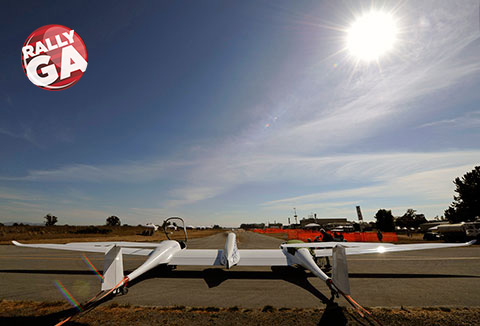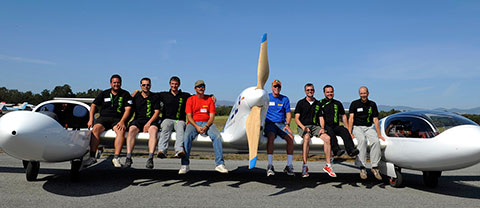Green flight challenge
Pipistrel takes home the $1.35 million grand prize
 The Pipistrel Taurus G4 four-seat electric-powered aircraft.
The Pipistrel Taurus G4 four-seat electric-powered aircraft.
In this nation’s history, the inevitable transition from horse to train to automobile had its share of forward thinkers, dreamers, charlatans, fools, and luminaries. New wasn’t always better, and an argument could always be made that any emerging technology had flaws so deep in its DNA that it would never succeed.
Not so much is different in the world of electric aircraft, although the days when most pilots dismissed voltage-driven flight as an impractical technological dead end are quickly fading. A profusion of hybrid-electric cars has shown a path to greater efficiency—at least right at the fuel pump—while making palatable the idea of an airplane that whirrs more than it rumbles.
Now all these designs need is a flashy venue to showcase their new technology and incredible efficiency, just what a bruised general-aviation populace needs in the face of rising costs and uncertainty about high-octane fuel.
 Team e-Genius won the Lindbergh Prize for Quietest Aircraft.
Team e-Genius won the Lindbergh Prize for Quietest Aircraft.
The Green Flight Challenge was just such a showcase. Sponsored by Google with a prize funded by NASA and run by the scrappy but always forward-looking CAFE Foundation of Santa Rosa, California, the Green Flight Challenge was lofted to bring into metal (or carbon fiber) real-world designs that could achieve unprecedented energy efficiency. The baseline requirements were fairly simple: Produce an airplane that could fly at a minimum of 100 mph, remain aloft for a 200-mile trip, and consume the equivalent of one gallon of fuel per passenger or less with at least two humans aboard. (An equivalency formula allowed the four-seat Pipistrel Taurus G4 to have two pilots and two sets of ballast.) Other tests to determine minimum takeoff performance and an acceptably low stall speed kept dangerously “single point” designs out of the competition.
Originally, 13 teams signed up for the Green Flight Challenge, all seeking the $1.35 million grand prize. Four met the starting bell, although one team was demoted to “exhibition” status because it had not fitted a ballistic recovery parachute that was part of the GFC requirements. The Embry Riddle Aeronautical University team arrived with the hardware in hand to outfit its modified Stemme S10 Eco-Eagle but ran out of time to complete the installation. What’s more, the ERAU staff faced an internal dilemma in that its members aren’t allowed to ride two-up in Experimental aircraft—yet the CAFE Foundation rules clearly called for two humans aboard. The gas-electric hybrid was allowed to fly but was not scored in the competition.
Two of the three remaining entrants also were modified motorgliders. The e-Genius is an all-electric 17-meter sailplane with a tail-mounted, 60-kilowatt electric motor driven by a 56-kilowatt-hour battery pack. It is based on the Pipistrel Taurus motorglider. A shoulder-wing design, the e-Genius employs retractable main landing gear in the fuselage behind the pilots. The Phoenix is a Rotax-912-powered conventional tractor sailplane built in the Czech Republic.
If some aircraft use fuel and some electricity, how do you rate them for efficiency? The CAFE Foundation says that one gallon of 87-octane auto fuel contains 115,000 BTU of energy, which is equivalent to 33.7 kilowatt-hours of electricity. For gas-powered aircraft, CAFE measures the weight before and after the flights used to establish economy to determine the fuel used. For electric aircraft, a battery run-down test determines the remaining energy in the battery pack after landing; comparing the reserve against the pack’s total capacity gives the amount of energy consumed during the flight.
 Team Pipistrel-USA
Team Pipistrel-USA
In the end, it was a runaway victory by the Pipistrel-USA team and the Taurus G4 that summoned the outsized check and shone a light on what can be done with existing technology. Pipistrel’s designer, Tine Tomazic, admits that the G4 is not what you’d build as a commercial venture. “We looked carefully at the rules and determined that a four-seat aircraft would have an advantage,” he says. “We didn’t have time to make an entirely new fuselage so the best choice was to join two Taurus fuselages. It was something we could do relatively quickly.”
Indeed, the design was begun in December 2010 and was ready to ship to the United States by May 2011. And the idea isn’t as crazy as it sounds. Mating the two fuselages provides a neat, strong center section to house the single engine plus one-third of the battery supply. “We know from designs like the P–38,” Tomazic says, “that you can have a very light structure for the maximum payload,” which is something an electric aircraft desperately needs to heft its power supply. In this case, a total battery capacity of 75 kilowatt-hours to drive the 200-horsepower electric motor; that pack of lithium-polymer batteries weighs more than 1,100 pounds. What’s more, the G4 employs separate, redundant electrical systems for the main systems and even has a solar cell on the right wing to help top off the battery dedicated to the avionics. As battery technologies develop, so too do their control systems. Turns out that managing a battery pack’s charge and discharge characteristics is key to reaping the most efficiency while maintaining safety.
So, how efficient was the Pipistrel? The final score presented by the CAFE Foundation was 403.5 passenger miles per gallon, a result that beat the e-Genius’ 375.8 pmpg. For that, Pipistrel won the grand prize and promises to continue its development of electric aircraft, more than broadly hinting that the next time you see an electric Pipistrel, it’ll be something you’ll want to admire—and own.
Marc Cook is a freelance writer and pilot living in Long Beach, California.


